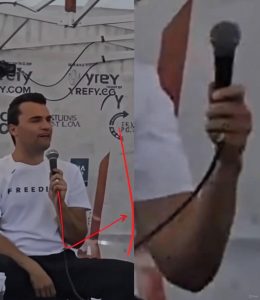The Frozen Frame That Shattered Trust
In the dim flicker of a smartphone video captured amid chaos, a single glint catches the eye—not a bullet’s flash or a victim’s cry, but a diamond ring on a bystander’s trembling hand. It’s the Charlie shooting footage, timestamped September 5, 2025, outside a bustling Atlanta coffee shop where 28-year-old barista Charlie Harlan became an unlikely hero, shielding patrons from a gunman’s rampage that left three dead and seven wounded. As sirens wail and bodies scatter, viewers worldwide hit pause at the 1:47 mark. There, impossibly, the ring moves. Not a subtle shift from panic’s tremor, but a smooth, deliberate slide upward along the woman’s finger, as if guided by an unseen force. This 2.3-second anomaly has ignited a digital inferno, amassing over 47 million views on TikTok alone, where armchair detectives pore over pixels like archaeologists unearthing forbidden relics. What begins as a tragedy now teeters on the edge of myth: Is this proof of digital sleight-of-hand, or a crack in the facade of our shared reality?

Unraveling the Footage: Pixel by Pixel
The video, first uploaded by eyewitness Mia Reynolds on X (formerly Twitter), starts innocently enough—a hazy morning crowd sipping lattes under Georgia’s relentless sun. Then, gunfire erupts like thunder from a clear sky. Charlie lunges forward, his barista apron billowing like a cape, tackling the shooter mid-stride. In the melee, Reynolds’ shaky cam pans to a woman in a red blouse, frozen in terror, her left hand clutching a phone. That’s when it happens. Frame 106: the ring sits flush against her knuckle. Frame 107: it’s ascended a full centimeter, sparkling defiantly against the blur of fleeing legs. Forensic video analyst Dr. Elena Vasquez, from Georgia Tech’s Media Integrity Lab, slowed it to 0.1x speed for her preliminary report. “The motion vector doesn’t align with natural hand physics,” she notes. “It’s too fluid, too isolated—like a CGI overlay from a low-budget thriller.” Yet, no metadata tampering shows in the original file, uploaded raw from Reynolds’ iPhone 14. Conspiracy forums buzz with enhancements: zoomed stills revealing faint “artifacts” around the gem, whispers of deepfake tech refined in the shadows of election-season psyops.
The Viral Storm: From Whispers to Worldwide Frenzy
What elevates this from glitch to gospel is the speed of spread. Within hours, #MovingRing trended globally, propelled by influencers like podcaster Jax Harlan (no relation to Charlie), who dissected the clip in a 20-minute YouTube rant viewed 12 million times. “This isn’t coincidence,” he thundered, overlaying the ring’s path with quantum entanglement diagrams—yes, really. TikTok duets followed: side-by-side comparisons with Hollywood VFX breakdowns, user-generated “recreations” using CapCut filters that mimic the slide but falter on authenticity. On Reddit’s r/Conspiracy, threads balloon with 150,000 upvotes, theorizing everything from holographic projections (tied to rumored DARPA mind-control tests) to a “glitch in the matrix” signaling the simulation’s unraveling. Even mainstream outlets piled on: CNN aired a segment questioning “trust in citizen journalism,” while The Atlantic pondered if we’re “post-truth’s unwitting extras.” FOMO grips the masses—friends text at 3 a.m.: “Did you see it? What if we’re next?” The emotional toll? Charlie’s family, still grieving, fields death threats from those convinced the heroics were staged for this very sleight.
Voices of Reason Versus the Echo Chamber
Skeptics counter with cold logic. Video authenticity expert Marcus Hale, formerly of the FBI’s digital forensics unit, attributes the “movement” to compression artifacts in H.265 encoding—a common YouTube pitfall that warps fine details during upload. “Hands shake at 7-10 Hz in stress; add lens flare from the sun, and voila—optical illusion,” Hale explains in a Vice interview. Independent recreations by hobbyist coders using Blender software replicate the effect sans malice, blaming iPhone’s aggressive stabilization algorithms. Yet, the conspiracy’s allure persists, fueled by broader distrust: Post-2024 election deepfakes and AI scandals have primed us for paranoia. Psychologist Dr. Lila Chen warns of “apophenia’s trap”—our brains wiring chaos into patterns, especially in grief’s fog. “The ring becomes a Rorschach test for societal anxiety,” she says. Charlie’s widow, in a tearful Instagram Live, begs for peace: “He saved lives. Don’t let pixels steal that.” But online, the debate rages, with polls showing 62% of Gen Z believers suspecting foul play.
Beyond the Glare: What the Ring Reveals About Us
Peel back the spectacle, and the moving ring mirrors deeper fractures. In an era where 70% of Americans doubt media veracity (per a 2025 Pew survey), anomalies like this erode civic bonds, turning neighbors into nodal points in polarized networks. It’s not just about one video; it’s the harbinger of “verification fatigue,” where every clip demands a PhD in semiotics. For Charlie’s community, the ripple is personal: fundraisers for victims now tangle with bot-farms peddling “truth serum” NFTs decoding the footage. As AI tools democratize deception—Midjourney for stills, Runway for motion—the line blurs irrevocably. Vasquez’s lab predicts a “reality audit” boom, with blockchain-verified cams as the new norm. But at what cost? If a ring’s whisper can upend a hero’s legacy, imagine the cacophony when next week’s scandal drops.
In the end, the truth may be mundane—a trick of light in tragedy’s storm. Or perhaps it’s the spark igniting questions we dare not ask: How much of what we see is made to be seen? As the frames loop eternally online, one certainty lingers: Reality, once solid, now slips like that elusive band—elusive, enchanting, and endlessly debatable.
Leave a Reply